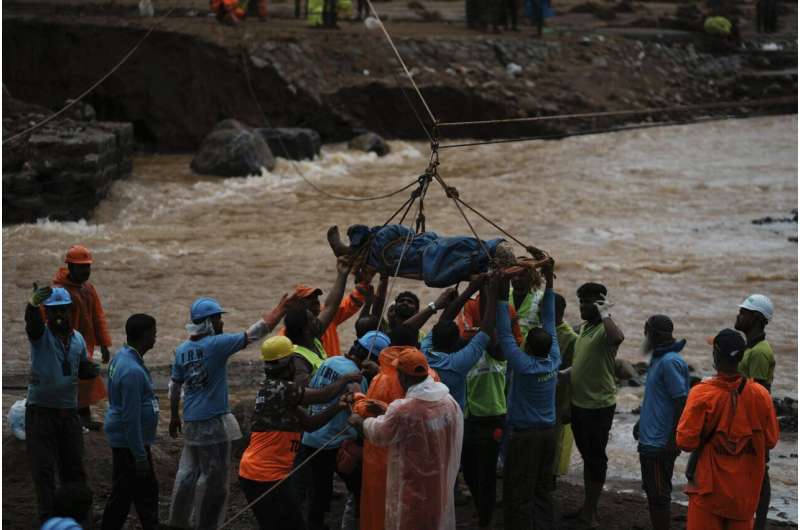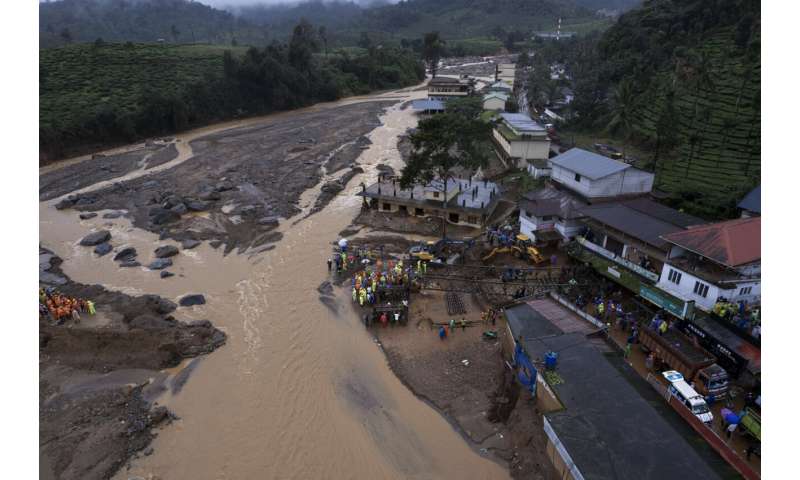This article has been reviewed according to Science X's editorial process and policies. Editors have highlighted the following attributes while ensuring the content's credibility:
fact-checked
reputable news agency
proofread
Study finds rains that led to deadly Indian landslides were made worse by climate change

The heavy rains that resulted in landslides killing hundreds in southern India last month were made worse by human-caused climate change, a rapid analysis by climate scientists found Tuesday.
The study by the World Weather Attribution, a group of scientists who use established climate models to quickly determine whether human-caused climate change played a part in extreme weather events around the world, found that the 15 centimeters (5.91 inches) of rain that fell in a 24-hour period July 29-30 was 10% more intense because of global warming. The group expects further emissions of planet-heating gases will result in increasingly frequent intense downpours that can lead to such disasters.
Nearly 200 people were killed and rescuers are still searching for more than 130 missing people in Kerala state, one of India's most popular tourist destinations.
"The Wayanad landslides are another catastrophic example of climate change playing out in real time," said Mariam Zachariah, a climate scientist at Imperial College of London and one of the authors of the rapid study.
Last month's rainfall that caused the landslides was the third-heaviest in Kerala state since India's weather agency began record-keeping in 1901.

Last year over 400 people died due to heavy rains in the Indian Himalayan state of Himachal Pradesh. Multiple studies have found that India's monsoon rains have become more erratic as a result of climate change. "Until the world replaces fossil fuels with renewable energy, monsoon downpours will continue to intensify, bringing landslides, floods and misery to India," said Zachariah.
India's southern state Kerala has been particularly vulnerable to climate change-driven extreme weather. Heavy rainfall in 2018 flooded large parts of the state, killing at least 500 people, and a cyclonic storm in 2017 killed at least 250 people including fishers who were at sea near the state's coasts.
"Millions of people are sweltering in deadly heat in the summer. Meanwhile, in monsoons, heavier downpours are fueling floods and landslides, like we saw in Wayanad," said Arpita Mondal, a climate scientist at the Indian Institute of Technology Bombay and one of the study's authors. Earlier this year another study by the same group found that deadly heat waves that killed at least 100 people in India were found to have been made at least 45 times more likely due to global warming.
-

Indian army soldiers set up a prefabricated bridge for across the river rescue operations following Tuesday’s landslides at Chooralmala, Wayanad district, Kerala state, India, Wednesday, July 31, 2024. Credit: AP Photo/Rafiq Maqbool -

People stand in a queue to check the identity of the victims at a morgue on the second day of the rescue mission following Tuesday's landslides at Meppadi, Wayanad district, Kerala state, India, Wednesday, July 31, 2024. Credit: AP Photo/Rafiq Maqbool
India, the world's most populous country, is among the highest current emitters of planet-heating gases and is also considered to be among the most vulnerable regions in the world to climate impacts.
"When it rains now, it rains heavily. In a warmer world, these extreme events will be more frequent and we cannot stop them. However, we can try to establish early warning systems for landslides and also avoid any construction activity in landslide-prone regions," said Madhavan Rajeevan, a retired senior official at India's Ministry of Earth Sciences who is from Kerala state.
Tuesday's study also recommended minimizing deforestation and quarrying, while improving early warning and evacuation systems to help protect people in the region from future landslides and floods. The study said the Wayanad region had seen a 62% decrease in forest cover and that that may have contributed to increased risks of landslides during heavy rains.
"Even heavier downpours are expected as the climate warms, which underscores the urgency to prepare for similar landslides in northern Kerala," said Maja Vahlberg, climate risk consultant at Red Cross Red Crescent Climate Centre who was also an author of the study.
© 2024 The Associated Press. All rights reserved. This material may not be published, broadcast, rewritten or redistributed without permission.



















